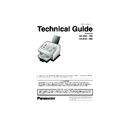Panasonic UF-590 / UF-790 / DX-600 / DX-800 Service Manual / Other ▷ View online
21
1.1.11
Printer Motor Drive Circuit
Motor Drive Circuit
The Printer Motor is a 4-phase uni-polar PM-type step motor. The step signals (pMMP0A to pMMP3A)
are transmitted to IC38 (the Chopper Drive Circuit) from IC3 SHINE output ports. The chopper current is
determined by the voltage at IC38, Pin3 and Pin13. The Printer Motor has two speeds, Slow and Con-
stant. The Printer Motor is powered by a +24 VDC supply. When the interlocks are open, the +24 VDC
supply is cut off and the Printer Motor stops rotating.
are transmitted to IC38 (the Chopper Drive Circuit) from IC3 SHINE output ports. The chopper current is
determined by the voltage at IC38, Pin3 and Pin13. The Printer Motor has two speeds, Slow and Con-
stant. The Printer Motor is powered by a +24 VDC supply. When the interlocks are open, the +24 VDC
supply is cut off and the Printer Motor stops rotating.
Pulse
Motor
Motor
Laser Printer Motor Drive Circuit Block Diagram
SHINE
IC3
+24 VM
3
1
6
4
pMMP0a
nMMP0a
pMMP2a
CN54
nMMP2a
Motor
Driver
IC38
22
Fuser Lamp Drive Circuit
The Fuser Lamp is powered by 100 VAC (200 VAC). It is driven by the LVPS and controlled by the nSSR
signal from the SC PC Board. When the CN103, Pin11 (nSSR) on the LVPS goes LOW, the Fuser Lamp
turns ON. This lights up the PC102 LED and activates the TRC100 photo-triac, and VAC 115 VAC is sent
to the Fuser Lamp. The time at which TRC100 is actually activated depends on the 100 VAC (200 VAC)
sine wave. When the cross-voltage for Pin 6 and Pin 4 of PC102 is other than 0 Volts (sine wave
exceeds 0 volts), PC102 inhibits the activation of the triac and turns ON the Fuser Lamp.
signal from the SC PC Board. When the CN103, Pin11 (nSSR) on the LVPS goes LOW, the Fuser Lamp
turns ON. This lights up the PC102 LED and activates the TRC100 photo-triac, and VAC 115 VAC is sent
to the Fuser Lamp. The time at which TRC100 is actually activated depends on the 100 VAC (200 VAC)
sine wave. When the cross-voltage for Pin 6 and Pin 4 of PC102 is other than 0 Volts (sine wave
exceeds 0 volts), PC102 inhibits the activation of the triac and turns ON the Fuser Lamp.
99
CN103
+24V
R127
4
2
1
PC102
nSSR
TRC100
2
1
2
1
C109
C108
R112
R111
R111
2
1
CN102
H
CN102
Fuser Lamp
Fuse
Thermostat
Thermal Fuse
3
SC PCB
6
LVPS
Fuser Lamp Drive Circuit Diagram
L301
L101
23
Fuser Temperature Control Circuit
The fuser temperature is controlled by IC1 on the SC PC Board, which contains A/D (Analog/Digital)
converters ANI0 to ANI7. The Fuser Temperature Control Circuit uses A/D converter, ANI1. When the
PC001 drive current is transmitted from the SC PC Board to the PSU (LVPS), the Fuser Lamp turns ON.
IC32 is a comparator with open output at pins 1 and 7 and is used as an abnormal temperature detection
circuit. IC32, pin 7, has a high impedance when Q44 is activated, turning ON the Fuser Lamp.
An abnormal temperature is detected when the VTH voltage level becomes higher than V+, forcing IC32,
pin 7 Low and deactivating Q44.
Abnormally low and high temperatures, as well as Thermistor release status, are detected by IC1 (CPU)
programming.
converters ANI0 to ANI7. The Fuser Temperature Control Circuit uses A/D converter, ANI1. When the
PC001 drive current is transmitted from the SC PC Board to the PSU (LVPS), the Fuser Lamp turns ON.
IC32 is a comparator with open output at pins 1 and 7 and is used as an abnormal temperature detection
circuit. IC32, pin 7, has a high impedance when Q44 is activated, turning ON the Fuser Lamp.
An abnormal temperature is detected when the VTH voltage level becomes higher than V+, forcing IC32,
pin 7 Low and deactivating Q44.
Abnormally low and high temperatures, as well as Thermistor release status, are detected by IC1 (CPU)
programming.
GND
GND
Q44
3
2
R394
R399
5
IC32
4
7
6
2
2
R398
GND
R397
R400
C214
R78
+5v
+24V
+3.3V
+3.3V
+3.3V
D26
C263
GND
PC001
1
2
6
4
+24v
R221
Thermistor
PSU (LVPS)
pSSRA
8
1
GND
Q43
3
1
Q42
3
1
79
SC PCB
2
1
CN52
TH2
D25
TH2
11
CN6
11
CN103
Fuser Temperature Control Circuit Diagram
(ANI1)
IC1
CPU
R401
R396
R395
IC3
SHINE
24
High Voltage Drive Circuit (Charging, Development and Transfer)
High Voltage is provided through a DC to DC converter, which changes the +24 VDC supply voltage to -
650 VDC, and output approximately 0.64 KVAC (Steady current: 200
650 VDC, and output approximately 0.64 KVAC (Steady current: 200
µ
A) for the Charging Block. The
Developer Circuit converts the +24 VDC to between -300 VDC for the development bias, and outputs
1,500 VAC (p-p) at a frequency of 1.650 kHz to charge the toner. The Transfer Circuit changes the +24
VDC supply voltage to approximately +280 VDC (MAX) (steady current:3
1,500 VAC (p-p) at a frequency of 1.650 kHz to charge the toner. The Transfer Circuit changes the +24
VDC supply voltage to approximately +280 VDC (MAX) (steady current:3
µ
A/-1500 VDC steady voltage).
3
GND
Q40
2
1
FG
Discharge Plate
Bias Transfer Roller
Bias Charge Roller
Development Roller
3
Q39
2
1
3
Q3
2
1
HVPS
CPU
pCR0
pCR1
pTR0
CN53
3
4
GND
T
C
D
5
SC PCB
Toner
Cartridge
Cartridge
High Voltage Drive Circuit
3
Q41
2
1
pDRCK
2
nDRCK
nTR0
nCR1
nCRCK
Click on the first or last page to see other UF-590 / UF-790 / DX-600 / DX-800 service manuals if exist.

